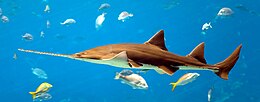櫛齒鋸鰩
櫛齒鋸鰩(學名:Pristis pectinata)是犁頭鰩目鋸鰩科鋸鰩屬的物種,分布於大西洋熱帶與亞熱帶地區沿岸水域以及河口灣處[3]。目前櫛齒鋸鰩正面臨極大的滅絕風險,分布範圍大大減少,IUCN將其評為極危物種[1]。
| 櫛齒鋸鰩 | |
|---|---|

| |
| 喬治亞水族館飼養的櫛齒鋸鰩 | |
| 科學分類 | |
| 界: | 動物界 Animalia |
| 門: | 脊索動物門 Chordata |
| 綱: | 軟骨魚綱 Chondrichthyes |
| 目: | 犁頭鰩目 Rhinopristiformes |
| 科: | 鋸鰩科 Pristidae |
| 屬: | 鋸鰩屬 Pristis |
| 種: | 櫛齒鋸鰩 P. pectinata
|
| 二名法 | |
| Pristis pectinata Latham, 1794
| |

| |
| 異名[2] | |
| |
物種分類
編輯外貌
編輯櫛齒鋸鰩上半身為棕黑色、灰色、藍灰色或黑色,而下半身為白色[6]。同鋸鰩科其他成員不同,櫛齒鋸鰩的背鰭末端與其腹鰭末端大約在同一位置。此外,其胸鰭和尾葉相對較小。櫛齒鋸鰩的鋸狀吻部較窄,有20-23顆鋸齒[6]。
物種分布
編輯櫛齒鋸鰩曾廣泛分布於大西洋的熱帶與亞熱帶水域,包括地中海、墨西哥灣、加勒比海等海區,北至美國南至烏拉圭和安哥拉的沿岸海域均能覓其蹤影,但目前其已在大部分區域滅絕[8]。目前尚有分布的國家包括巴哈馬、貝里斯、古巴、宏都拉斯、獅子山和美國的大西洋潮間帶。雖然在茅利塔尼亞和幾內亞比索有相關目擊報告,但這兩次報告僅被確定為鋸鰩屬的物種(Pristis sp.),無法認定是否為櫛齒鋸鰩[1]。
生態
編輯櫛齒鋸鰩的幼魚生活於河流、運河、溪流等較淺的淡水水域[9],隨著年齡增大會逐漸遷徙至鹽度更高的河流下游並最終進入海水。成年櫛齒鋸鰩多分布於沿岸水域或是河口灣的淺水區,一般水深不超過8公尺[10]。櫛齒鋸鰩最理想的棲息地為紅樹林與海草床等海床多泥沙的環境,偶爾亦會出沒於珊瑚礁附近[11]。
櫛齒鋸鰩的吻部有數千個能感應電場的器官,尤其集中於上半部分。櫛齒鋸鰩在捕獵時會通過這些器官偵測電場的變動來定位附近的動物,故其在能見度極低的水域亦能找到獵物,同時也能感知到躲藏於泥沙中的獵物[12]。在找到底棲獵物後,櫛齒鋸鰩會使用其鋸狀結構將其挖出,而對於水中游泳的獵物則會用將其刺穿或擊暈[13]。昆士蘭大學的研究員將投餵櫛齒鋸鰩的食物分為從水面落下和直接放置於魚缸底部兩組,並發現其會用鋸狀結構挑起那些放置於缸底的食物,而對於水面落下的食物櫛齒鋸鰩則會將其刺穿,這與其野生環境下的捕食習性相符。其主要的獵物為軟體動物和甲殼類[14] 。
櫛齒鋸鰩在遭受威脅時會揮舞其鋸狀結構進行自衛,包括被人類捕獲的情況,但在沒有感受到威脅時其一般不會主動攻擊人類[15]。
繁殖
編輯櫛齒鋸鰩每兩年繁殖一次,為卵胎生物種,即幼魚孵化後留在母魚體內,依靠卵黃獲取營養直到發育完全後再誕生。櫛齒鋸鰩一胎產下15-20條幼魚[16]。尋求伴侶的櫛齒鋸鰩會利用其「鋸子」(即形似鋸子的吻部)上的勞倫氏壺腹定位異性的位置,並通過齧咬彼此胸鰭的方式來示愛[17]。在確定交配對象後,雄性櫛齒鋸鰩會將其鰭足插入雌性的陰道,並藉助其虹吸囊將精子推入雌性體內。交配完成後,櫛齒鋸鰩會立刻離開配偶繼續獨自生活[17]。
關於櫛齒鋸鰩具體性成熟長度尚有爭議,2005年的文獻認為雄性和雌性櫛齒鋸鰩的性成熟長度分別為270公分和360公分[16],2012年IUCN報告稱目前捕獲最小的性成熟雄性為370公分,雌性則為415公分[1],也有網站稱捕獲了340公分長的雄性成年個體[18][19]以及370公分[19]和380公分[18]長的雌性成年個體。有學者按實際數據通過馮·貝塔郎非函數反推得出雄性的性成熟年齡為7.5歲,雌性則是10-12歲[20]。
除此以外,科學家於2014年發現佛羅里達州沿岸的櫛齒鋸鰩族群會進行單性繁殖,並估算大約3%的個體都是單性繁殖所生。他們推測櫛齒鋸鰩進行單性繁殖的原因是由於本地種群衰退嚴重、雌魚難以找到交配的雄魚所致[21]。
人工繁殖
編輯2012年5月,巴哈馬亞特蘭蒂斯度假中心水族館宣稱該年4月館內誕下2公2母共4條櫛齒鋸鰩,隨後得到動物園和水族館協會確認,這是目前唯一一種在人工環境下繁殖的鋸鰩[22]。
物種保護
編輯櫛齒鋸鰩種群目前正瀕臨滅絕,IUCN將其評為極危物種。目前其種群受到的威脅主要來自於漁業[1]。自19世紀起美國東南部沿海即有對櫛齒鋸鰩的大規模商業捕撈,致使其種群大減,而自20世紀70年代以來由於捕魚技術的發展以及對鯊魚製品的需求使得西非沿海亦開始大規模捕撈櫛齒鋸鰩,並最終致使該魚在許多西非國家(例如貝寧、喀麥隆、加納)區域性滅絕[1][23]。雖然目前櫛齒鋸鰩的種群已衰退至商業捕撈完全無利可圖的境地,但其鋸狀的吻部仍然使得其極易纏入拖網,作為兼捕被漁民意外捕獲。由於其吻部作為裝飾品或是儀式用品價值極高,魚翅亦可賣出高價,因此漁民在捕獲櫛齒鋸鰩後可能選擇將其殺死並獲取其鋸狀吻部和魚翅以出售[24]。即使櫛齒鋸鰩被放生,其亦有可能死於漁網所造成的傷口[1]。除此之外,沿海地區的經濟發展和海洋污染亦會破壞其主要棲息地海藻床與紅樹林,對其種群造成一定影響。目前,櫛齒鋸鰩同其他鋸鰩科成員一樣名列CITES I,且美國、墨西哥、尼加拉瓜、塞內加爾、厄瓜多等國均出台了一系列政策來保護櫛齒鋸鰩[1]。
畫廊
編輯參考
編輯- ^ 1.0 1.1 1.2 1.3 1.4 1.5 1.6 1.7 Carlson, J.; Wiley, T.; Smith, K. Pristis pectinata. The IUCN Red List of Threatened Species. 2013, 2013: e.T18175A141791261 [19 November 2021]. doi:10.2305/IUCN.UK.2013-1.RLTS.T18175A141791261.en .
- ^ William N Eschmeyer; Ron Fricke. Richard van der Laan , 編. Species that contain: Pristis and pectinata. Californian Academy of Science. [2022-11-21]. (原始內容存檔於2022-10-10).
- ^ Poulakis, Gregg R.; Stevens, Philip W.; Timmers, Amy A.; Stafford, Christopher J.; Chapman, Demian D.; Feldheim, Kevin A.; Heupel, Michelle R.; Curtis, Caitlin. Long-term site fidelity of endangered small-tooth sawfish (Pristis pectinata) from different mothers (PDF). Fishery Bulletin. 2016, 114 (4): 461–475 [2022-09-30]. doi:10.7755/fb.114.4.8 . (原始內容 (PDF)存檔於2017-01-25).
- ^ Latham, J.F. An essay on the various species of sawfish. The Transactions of the Linnean Society of London. 1794, 2 (25): 273–282.
- ^ Kyne, P.M; Wang, J.J; Xiang, D.; Chen, X.; Feutry, P. The phylogenomic position of the Critically Endangered Largetooth Sawfish Pristis pristis (Rhinopristiformes, Pristidae), inferred from the complete mitochondrial genome. Mitochondrial DNA B Resour. 2018, 3 (2): 970–971 [2022-11-21]. doi:10.1080/23802359.2018.1501315. (原始內容存檔於2022-11-21).
- ^ 6.0 6.1 Kells, V. & K. Carpenter. A Field Guide to Coastal Fishes from Texas to Maine. Johns Hopkins University Press. 2015: 82. ISBN 978-0-8018-9838-9.
- ^ Slaughter, Bob H.; Springer, Stewart. Replacement of Rostral Teeth in Sawfishes and Sawsharks. Copeia. 1968, 1968 (3): 499–506. JSTOR 1442018. doi:10.2307/1442018.
- ^ Dulvy; Davidson; Kyne; Simpfendorfer; Harrison; Carlson & Fordham. Ghosts of the coast: global extinction risk and conservation of sawfishes (PDF). Aquatic Conserv: Mar. Freshw. Ecosyst. 2014, 26 (1): 134–153 [2022-10-01]. doi:10.1002/aqc.2525 . (原始內容存檔 (PDF)於2022-10-01).
- ^ Simpfendorfer, C.A., Wiley, T.R., and Yeiser, B.G. 2010. Improving conservation planning for an endangered sawfish using data from acoustic telemetry. Biological Conservation 143(6): 1460-1469.
- ^ Whitty, J.; N. Phillips & R. Scharfer. Pristis pectinata (Latham, 1794). Sawfish Conservation Society. [17 November 2017]. (原始內容存檔於2020-10-31).
- ^ Norton, S., Wiley, T.R., Carlson, J.K., Frick, A.L., Poulakis, G.R., and Simpfendorfer, C.A. 2012. Designating critical habitat for the endangered smalltooth sawfish Pristis pectinata in the United States: challenges and results. Marine and Coastal Fisheries: Dynamics, Management, and Ecosystem Science 4: 473-480.
- ^ Wueringer, B.E.; Peverell, S.C.; Seymour, J.; Squire Jr., L.; Kajiura, S.M.; Collin, S.P. Sensory Systems in Sawfishes. 1. The Ampullae of Lorenzini. Brain, Behavior and Evolution. 1 January 2011, 78 (2): 139–149. PMID 21829004. S2CID 16357946. doi:10.1159/000329515.
- ^ Barbara E. Wueringer; Lyle Squire Jr.; Shaun P. Collin. The biology of extinct and extant sawfish (Batoidea: Sclerorhynchidae and Pristidae). Reviews in Fish Biology and Fisheries. 2009, 19 (4): 445–464. S2CID 3352391. doi:10.1007/s11160-009-9112-7.
- ^ Wueringer, Barbara E.; Squire, Lyle; Kajiura, Stephen M.; Hart, Nathan S.; Collin, Shaun P. The function of the sawfish's saw. Current Biology. 1 March 2012, 22 (5): R150–R151. PMID 22401891. doi:10.1016/j.cub.2012.01.055 .
- ^ Michael, Scott W. Reef Sharks & Rays of the World. Prostar Pubns. 2005. ISBN 978-1577855385.
- ^ 16.0 16.1 Simpfendorfer, C. A. 2005. Threatened fishes of the world: Pristis pectinata Latham, 1794 (Pristidae). Environmental Biology of Fishes 73: 20.
- ^ 17.0 17.1 Pratt, Harold L.; Carrier, Jeffrey C. A review of elasmobranch reproductive behavior with a case study on the nurse shark, Ginglymostoma cirratum. The behavior and sensory biology of elasmobranch fishes: an anthology in memory of Donald Richard Nelson (Springer Netherlands). 2001: 157–188 [2022-11-04]. doi:10.1007/978-94-017-3245-1_11. (原始內容存檔於2022-11-04) (英語).
- ^ 18.0 18.1 Florida Fish and Wildlife Conservation Commission. General Information on Smalltooth Sawfish. [2022-11-06]. (原始內容存檔於2022-11-06).
- ^ 19.0 19.1 BIMINI BIOLOGICAL FIELD STATION FOUNDATION. SMALLTOOTH SAWFISH. [2022-11-06]. (原始內容存檔於2022-11-04).
- ^ Scharer, R.M., Patterson, W.F., Carlson, J.K. and Poulakis, G.R. 2012. Age and growth of smalltooth sawfish (Pristis pectinata) verified with LA-ICP-MS analysis of vertebrae. PLoS One 7(10): e47850.
- ^ Critically Endangered Ocean Giant is Reproducing Without Sex in the Wild |. June 2015 [2022-10-05]. (原始內容存檔於2015-06-05).
- ^ White, S. & K. Duke. Smith; Warmolts; Thoney; Hueter; Murray & Ezcurra , 編. Husbandry of sawfishes. Elasmobranch Husbandry Manual II (Special Publication of the Ohio Biological Survey). 2017: 75–85. ISBN 978-0-86727-166-9.
- ^ Diop, M. and Dossa, J. 2011. 30 Years of Shark Fishing in West Africa. FIBA.
- ^ McDavitt, M.T. 2005. Summary of trade in sawfishes and sawfish parts. Unpublished Report.
外部連結
編輯
